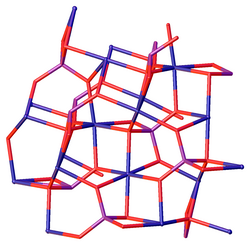 | |
 | |
| Names | |
|---|---|
| IUPAC name Nickel(2+) diphosphate | |
| Other names Nickel(III) phosphate, nickel diphosphate | |
| Identifiers | |
3D model (JSmol) | |
| ChemSpider | |
| ECHA InfoCard | 100.030.755 |
| EC Number |
|
PubChem CID | |
| UNII | |
CompTox Dashboard (EPA) | |
| |
| |
| Properties | |
| Ni3(PO4)2 | |
| Molar mass | 366.022924 g/mol |
| Appearance | Green solid |
| Density | 4.38 g/cm3 |
Solubility product (Ksp) | 4.74×10−32 [1] |
| Structure [2] | |
| Monoclinic, mP26 | |
| P21/c, No. 14 | |
a = 0.58273 nm, b = 0.46964 nm, c = 1.01059 nm α = 90°, β = 91.138°, γ = 90° | |
| Hazards | |
| GHS labelling: | |
   | |
| Danger | |
| H317, H334, H372, H410 | |
| P203, P260, P261, P264, P270, P272, P273, P280, P284, P302+P352, P304+P340, P318, P319, P321, P333+P317, P342+P316, P362+P364, P391, P405, P501 | |
| NFPA 704 (fire diamond) | |
| Safety data sheet (SDS) | www.fishersci.com |
Except where otherwise noted, data are given for materials in their standard state (at 25 °C [77 °F], 100 kPa). | |
Nickel(II) phosphate is an inorganic compound with the formula Ni3(PO4)2. It is a mint green paramagnetic solid that is insoluble in water. [3]

